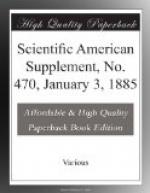bad to fabrics so colored; but the practical dyer
or calico printer knows that though he employs these
poisonous bodies in his business, and that some portion
of them does actually accompany the dyed material in
its finished state, not only is the quantity excessively
small, but that it is in such a state of combination
as to be completely inert and innoxious. In the
case of tartar emetic, it is the tannate of antimony
which remains upon the cloth, a compound of considerable
stability, and almost perfectly insoluble in water;
in the case of a few colors fixed by the arsenical
alumina mordant, the arsenic is in an insoluble state
of combination with the alumina, in fact, the poisons
are in the presence of their antidotes, and not even
the most scrupulous manufacturer has any fear that
he is turning out goods which can be hurtful to the
wearer. Persons quite unacquainted with the process
of dyeing are apt to think that goods are dyed by
simply immersing them in a colored liquid and then
drying them with all the color on them and all that
the color contains; they do not know that in all usual
cases of dyeing a careful washing in a plentiful supply
of water is the final process in the dye-house, and
that nothing remains upon the cloth which can be washed
out by water, the color being retained by a sort of
attraction or affinity between it and the fiber, or
mordant on the fiber. Dyeing is not like painting
or even the printing or staining of paper for hangings,
where the vehicle and color in its entirety is applied
and remains. It follows, therefore, that many
chemicals used in dyeing have only a transitory use,
and are washed away completely—such as
oil of vitriol, much used in woolen dyeing—and
that of others only a very minute quantity is finally
left on the cloth, as is the case in antimony and
arsenic in cotton dyeing and printing.
There is evidently among working dyers, as among all
other classes, an unknown amount of carelessness,
ignorance, and stupidity, from which employers are
constantly suffering in the shape of spoiled colors
and rotted cloth. It is not for us to say that
the public may not at times have to suffer also from
neglect of the most common treatments which should
remove injurious matters from dyed goods; what can
be said is, that if the dyeing processes for aniline
colors be followed out with ordinary care and intelligence,
it is extremely improbable that anything left in the
material should be injurious to human health.—Manchester
Textile Recorder.
* * * *
*
CASE OF RESUSCITATION AND RECOVERY AFTER APPARENT DEATH BY HANGING.
By ERNEST W. WHITE, M.B. Lond., M.R.C.P., Senior
Assistant Medical Officer to the Kent Lunatic Asylum;
Associate, Late Scholar, of King’s College,
London.
The following case, from its hopelessness at the outset,
yet ultimate recovery under the duly recognized forms
of treatment, is of such interest as to demand publicity,
and will afford encouragement to others in moments
of doubt.




